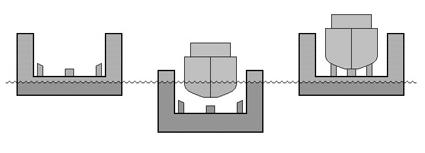During the 12 May 1994 meeting of the Puget Sound Section of the American Society of Naval Engineers, I met some young engineering-duty officers. When one told me that she was the docking officer in Puget Sound Naval Shipyard, my first though was that the ultra-conservative Navy has come a long way. The young woman reminded me of my daughter Gina, and I was instantly confident that she was more effective at that job than many of the macho waterfront types that I encountered over the years.
Someone suggested that I tell the officers about the Scandahoovian dock master.

There was a certain no-nonsense aura about individuals who were in charge of docking and undocking ships, particularly in floating dry docks. They were in a class with harbor pilots and many years of experience as an assistant were prerequisite for achieving the title dock master. As soon as the bow of a ship crossed the sill of a dry dock, the dock master assumed command. The story that I was prompted to tell was about the dock master in a Brooklyn shipyard years before megaphones were electronically amplified. I’ll call him Sven, a dour product of Scandinavia who, at some time in his past, had acquired reason to mistrust everyone.
Regardless of the weather, with the carpenters and riggers standing by, Sven personally measured the height of every block and checked to see that the chains for positioning bilge blocks were free. “Why doesn’t he spot check?,” the workers grumbled.
Immediately before each docking, with line handlers manning the dock’s wing walls, even during a downpour of rain mixed with sleet, Sven took his sweet time in a final check, and from the dock floor gave the command to start flooding ballast tanks.
Barely an instant before the dock floor became immersed, in fact with uncanny timing that exuded professionalism, Sven stepped into a rowboat. Just then, the dock suddenly dropped a few feet due to what naval architects describe as a diminishing waterplane area. While sculling the boat with one hand and holding the megaphone with the other, Sven didn’t miss a beat in barking orders to the line handlers. He repeatedly circled the ship while yelling terse commands for positioning and deballasting. The process seemed to take forever.
The frustrated line handlers collaborated with the exasperated carpenters in preparing for a February day when a docking would be further complicated by ice flows. Chunks of ice that came down the Hudson River, due to tidal action, accumulated in the basin where the dock was located.
The night before, the carpenters nailed Sven’s rowboat to the dock floor.
***************
Copyright © 2006 (text only) by Louis D. Chirillo
